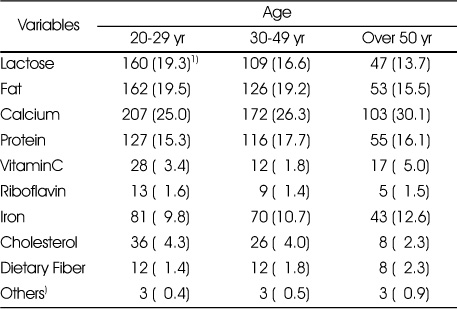Milk Intake Patterns with Lactose and Milk Fat in Korean Male Adults
Article information
Abstract
Objectives
This study examined the milk intake patterns with lactose and milk fat in Korean male adults using the following variables: milk intake level, awareness of lactose, and milk fat, health problems, and necessity of milk intake. In addition, the factors affecting milk intake were analyzed by multiple regression analysis.
Methods
The subjects were 532 males aged 20 years or older among the nationwide milk purchasing group. The subjects were 223 (41.9%) in the 20–29 year age group, 188 (35.3%) in the 30–49 year age group and 121(22.7%) in the over 50 year age group. The survey was conducted using ANOVA and multiple comparative analysis to examine the differences in age and multiple regression analysis was performed to investigate the factors affecting the intake of milk.
Results
The intake of milk in the subjects was 538.14 ± 494.23 ml per week. There were statistically significant differences in the subjects' age according to processed milk, low fat, nonfat milk, cheese, and ice cream. The perception of milk and lactose and milk fat was recognized as a good food for skeletal health when milk was consumed. Among the milk nutrients, lactose was highly recognized at the age of 20–29, and milk fat was recognized in those over 50 years. In addition to lactose and milk fat, calcium was the most highly recognized among the milk nutrients. Health problems associated with milk were skeletal health, obesity, and lactose intolerance. The perception of lactose intolerance was related to lactose intolerance and fatness, and the dietary behavior was unaffected.
Conclusions
This study examined the milk intake patterns of adult Korean males. Many variables were found to be related to the intake of milk. In this study, the milk intake was high when there was no problem with the perception and dietary behaviors of milk nutrition (lactose and milk fat). This study focused on lactose and milk fat, which are major nutrients in milk, and it is a new perspective study among milk-related research.
Acknowledgments
This research was supported by a grant (2016-01) from Korea Milk Marketing Board in 2016.










